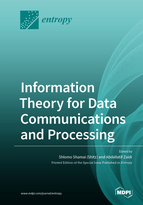Information Theory for Data Communications and Processing
A special issue of Entropy (ISSN 1099-4300).
Deadline for manuscript submissions: closed (30 September 2019) | Viewed by 45349
Special Issue Editors
Interests: multi-user information theory; modern communication networks (cloud and fog radio networks); information and signal processing (information–estimation); information bottleneck problems in communications and learning; sparse communications models and non-orthogonal (NOMA) systems
Special Issues, Collections and Topics in MDPI journals
Special Issue Information
Dear Colleagues,
This Special Issue focuses on fundamental information-theoretic aspects of remote processing in networks. We welcome unpublished contributions related to advanced distributed data processing techniques distributively in networks. Examples include signal processing solutions based on communication and information-theoretic considerations, for Cloud and Fog Radio Access Networks (RAN), remote source coding, as well as interdisciplinary connections with problems such as information bottleneck, information-theoretic learning and prediction, distributed estimation and decision making, secrecy/privacy and identification in communication systems.
Prof. Dr. Shlomo Shamai (Shitz)
Prof. Dr. Abdellatif Zaidi
Guest Editors
Manuscript Submission Information
Manuscripts should be submitted online at www.mdpi.com by registering and logging in to this website. Once you are registered, click here to go to the submission form. Manuscripts can be submitted until the deadline. All submissions that pass pre-check are peer-reviewed. Accepted papers will be published continuously in the journal (as soon as accepted) and will be listed together on the special issue website. Research articles, review articles as well as short communications are invited. For planned papers, a title and short abstract (about 100 words) can be sent to the Editorial Office for announcement on this website.
Submitted manuscripts should not have been published previously, nor be under consideration for publication elsewhere (except conference proceedings papers). All manuscripts are thoroughly refereed through a single-blind peer-review process. A guide for authors and other relevant information for submission of manuscripts is available on the Instructions for Authors page. Entropy is an international peer-reviewed open access monthly journal published by MDPI.
Please visit the Instructions for Authors page before submitting a manuscript. The Article Processing Charge (APC) for publication in this open access journal is 2600 CHF (Swiss Francs). Submitted papers should be well formatted and use good English. Authors may use MDPI's English editing service prior to publication or during author revisions.
Keywords
- Fog and Cloud RANs
- Remote source coding and indirect rate distortion theory
- Chief Executive Officer (CEO) source coding problems
- Noisy network coding
- Distributed estimation
- Information Bottleneck
- Information theoretic aspects of prediction and Deep learning
- Universal compression
- Hypothesis testing and statistics
- Caching
- Network information theoretic frameworks, including: multiple access, broadcast, relay, wiretap and X channels








